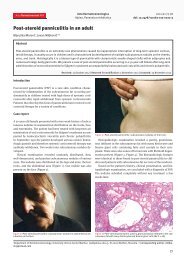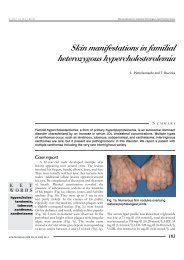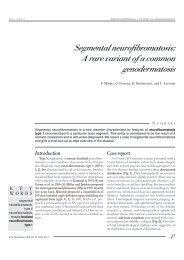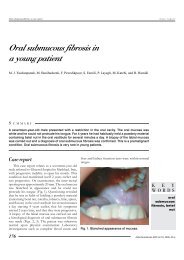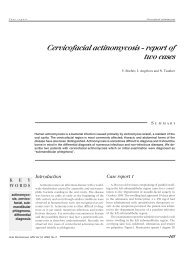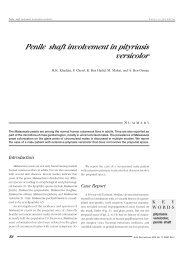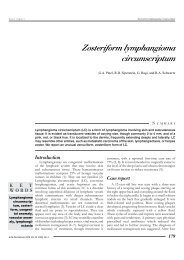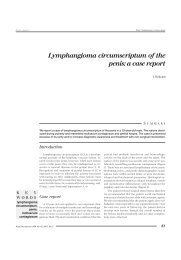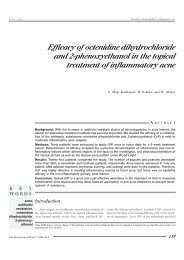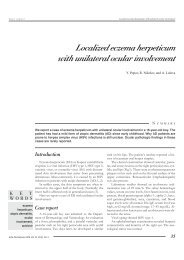Giant keratoacanthoma-like cutaneous horn of the upper leg: A case ...
Giant keratoacanthoma-like cutaneous horn of the upper leg: A case ...
Giant keratoacanthoma-like cutaneous horn of the upper leg: A case ...
Create successful ePaper yourself
Turn your PDF publications into a flip-book with our unique Google optimized e-Paper software.
Case report<strong>Giant</strong> <strong>keratoacanthoma</strong>-<strong>like</strong> <strong>cutaneous</strong> <strong>horn</strong> <strong>of</strong> <strong>the</strong> <strong>upper</strong> <strong>leg</strong>: A <strong>case</strong> report<strong>Giant</strong> <strong>keratoacanthoma</strong>-<strong>like</strong> <strong>cutaneous</strong><strong>horn</strong> <strong>of</strong> <strong>the</strong> <strong>upper</strong> <strong>leg</strong>:A <strong>case</strong> reportU. Wollina and J. SchönlebeA BSTRACT<strong>Giant</strong> <strong>cutaneous</strong> <strong>horn</strong>s are suspicious <strong>of</strong> malignancy, in particular squamous cell carcinoma. Wereport on a 67-year-old man that developed a giant <strong>horn</strong> on his <strong>upper</strong> <strong>leg</strong> that resembled a <strong>keratoacanthoma</strong>.The lesion was surgically removed. Histologic investigation revealed a giant verrucavulgaris. No risk factors such as immunosuppression were evident. <strong>Giant</strong> verruca vulgaris is a veryrare cause <strong>of</strong> giant <strong>cutaneous</strong> <strong>horn</strong>s. Complete excision is recommended in order not to overlooka malignant skin tumor in such <strong>case</strong>s.K E YWORDSgiant<strong>cutaneous</strong> <strong>horn</strong>,giant verrucavulgaris,squamous cellcarcinomaIntroductionActa Dermatoven APA Vol 19, 2010, No 2Cutaneous <strong>horn</strong>, or cornu cutaneum, is a conicalhyperkatotic projection <strong>of</strong> skin with a remarkable cohesiveness<strong>of</strong> <strong>the</strong> keratotic material. They resembleanimal <strong>horn</strong>s at first glance. Most <strong>of</strong> <strong>the</strong>m develop onface and scalp, but any part <strong>of</strong> <strong>the</strong> body can be involved.<strong>Giant</strong> <strong>cutaneous</strong> <strong>horn</strong>s are uncommon (1, 2). It hasbeen suggested that about 40% <strong>of</strong> <strong>cutaneous</strong> <strong>horn</strong>soccur as premalignant or malignant lesions (2).Here we report a patient with a giant <strong>cutaneous</strong><strong>horn</strong> on an unusual site – <strong>the</strong> <strong>upper</strong> <strong>leg</strong> – with variousclinical differential diagnoses.Case reportA 67-year-old man presented with a <strong>cutaneous</strong><strong>horn</strong> on his right distal <strong>upper</strong> <strong>leg</strong>. The tumor had beengrowing for about 6 months. There was no history <strong>of</strong>trauma.On examination a <strong>cutaneous</strong> <strong>horn</strong> <strong>of</strong> about 3 cmmaximum diameter was found on <strong>the</strong> <strong>upper</strong> <strong>leg</strong>. Thesurrounding skin was slightly ery<strong>the</strong>matous and <strong>the</strong>rewere enlarged capillaries close to <strong>the</strong> tumor base. Thetumor was painless and resembled <strong>keratoacanthoma</strong>(Fig. 1).A complete surgical excision with safety margins<strong>of</strong> at least 1 cm was performed. The wound healedby primary intention. The postoperative course wasuneventful.Histologic examination showed a complete symmetricalepi<strong>the</strong>lial lesion. The prominent epidermalacanthosis with formation <strong>of</strong> a <strong>cutaneous</strong> <strong>horn</strong> wasassociated with prominent papillomatosis. Focally<strong>the</strong>re was hypergranulosis with enlarged keratohyalingranules and hyperparakeratotic columns. Koilocyteswere also seen. The basal membrane zone did not con-29
<strong>Giant</strong> <strong>keratoacanthoma</strong>-<strong>like</strong> <strong>cutaneous</strong> <strong>horn</strong> <strong>of</strong> <strong>the</strong> <strong>upper</strong> <strong>leg</strong>: A <strong>case</strong> reportCase reportFigure 1. Clinical presentation <strong>of</strong> a <strong>cutaneous</strong><strong>horn</strong> on <strong>the</strong> <strong>upper</strong> <strong>leg</strong>: gross view.tain abnormalities. Some mitoses could be found in<strong>the</strong> basal cell layer but <strong>the</strong>re were no atypical cells oratypical mitoses.The histopathology was <strong>the</strong>refore typical for a verrucavulgaris (Fig. 2).DiscussionCommon warts are benign epi<strong>the</strong>lial tumors inducedby infection with human papilloma virus(HPV). <strong>Giant</strong> verrucae vulgares are uncommon (3,4). The one described here clinically resembled a <strong>keratoacanthoma</strong>or <strong>keratoacanthoma</strong>-<strong>like</strong> squamous cellcarcinoma. The brief history <strong>of</strong> about 6 months wasmore <strong>like</strong>ly to indicate <strong>keratoacanthoma</strong>. However,Figure 2. Histologic examination <strong>of</strong> <strong>the</strong> <strong>cutaneous</strong><strong>horn</strong> demonstrated a giant verruca vulgaris: detail(HE, ×4).histological examination confirmed <strong>the</strong> diagnosis <strong>of</strong> agiant verruca vulgaris.<strong>Giant</strong> HPV tumors are most common in <strong>the</strong> anogenitalarea and are known as Buschke-Loewensteintumors. They are probably related to peculiarities <strong>of</strong><strong>the</strong> skin and <strong>the</strong> predominance <strong>of</strong> certain HPV subtypes.No risk factor has yet been identified for giantverruca vulgaris.A complete excision <strong>of</strong> <strong>the</strong>se lesions and a completehistologic analysis is important in order not tooverlook major differential diagnoses such as <strong>keratoacanthoma</strong>-<strong>like</strong>squamous cell carcinoma, verrucouscarcinoma, or deep mycotic infections (5–7).1. Michal M, Bisceglia M, Di Mattia A, Requena L, Fanburg-Smith JC,Mukensnabl P, Hes O, Cada F. Gigantic <strong>cutaneous</strong> <strong>horn</strong>s <strong>of</strong> <strong>the</strong> scalp.R EFERENCESLesions with a gross similarity to <strong>the</strong> <strong>horn</strong>s <strong>of</strong> animals: a report <strong>of</strong> four <strong>case</strong>s. Am J Surg Pathol. 2002;26:789–94.2. Nthumba PM. <strong>Giant</strong> <strong>cutaneous</strong> <strong>horn</strong> in an African woman: a <strong>case</strong> report. J Med Case Reports. 2007;1:70.3. Xu A, Wang S, Cheng D, Wang P. A rare <strong>case</strong> <strong>of</strong> large, unusual, and mutilating verruca vulgaris with <strong>cutaneous</strong><strong>horn</strong>s treated with plastic surgery. Cutis. 2007;80:145–8.4. Ergün SS, Su Ö, Büyükbabaný N. <strong>Giant</strong> verruca vulgaris. Dermatol Surg. 2004;30:459–62.5. AlShahwan MA, AlGhamdi KM, AlSaif FM. Verrucous carcinoma presenting as giant plantar <strong>horn</strong>s. DermatolSurg. 2007;33:510–2.6. Thappa DM, Garg BR, Thadeus J, Ratnakar C. Cutaneous <strong>horn</strong>: a brief review and report <strong>of</strong> a <strong>case</strong>. J Dermatol.1997;24:34–7.7. Boudghène-Stambouli O, Mérad-Boudia A. Maladie dermatophytique: hyperkératose exubérante avec cornescutanées. Ann Dermatol Venereol. 1998;125:705–7.AUTHORS’A D D R E S S30Uwe Wollina, MD, Department <strong>of</strong> Dermatology and Allergology and GeorgSchmorl Institute <strong>of</strong> Pathology, Dresden-Friedrichstadt Hospital, AcademicTeaching Hospital <strong>of</strong> <strong>the</strong> Technical University <strong>of</strong> Dresden, 01067 Dresden,Germany, corresponding author, E-mail: wollina-uw@khdf.deJaqueline Schönlebe, MD, same addressActa Dermatoven APA Vol 19, 2010, No 2
Case reportActinic lichen planus <strong>of</strong> unusual presentationActinic lichen planus<strong>of</strong> unusual presentationA. Mebazaa, M. Denguezli, N. Ghariani, B. Sriha, C. Belajouza, and R. NouiraA BSTRACTActinic lichen planus (ALP) is a distinct variant <strong>of</strong> lichen planus mainly involving teenagers withan Asian racial pr<strong>of</strong>ile. Three clinical types <strong>of</strong> ALP have been described: annular, pigmented, anddyschromic. We report an ALP with unusual presentation in a 56-year-old woman with no relevantmedical history, which was clinically suggestive <strong>of</strong> actinic keratosis. Histological findings refined<strong>the</strong> diagnosis by showing typical aspects <strong>of</strong> lichen planus. This dermatosis, which is frequent inTunisia because <strong>of</strong> sun exposure, may cause mainly aes<strong>the</strong>tic damage and requires adequate photoprotection.K E YWORDSactinic lichenplanus, Tunisia,sun exposureIntroductionActa Dermatoven APA Vol 19, 2010, No 2Actinic lichen planus (ALP), also known as lichenplanus tropicus, is a rare variant <strong>of</strong> LP that typically affectschildren or young adults with dark skin that livein tropical or subtropical regions (1, 2). This particularform <strong>of</strong> LP generally occurs on light-exposed areas.Three clinical types <strong>of</strong> ALP have been described: annular,pigmented, and dyschromic (1, 2). We report a<strong>case</strong> <strong>of</strong> ALP <strong>of</strong> unusual presentation, mimicking actinickeratosis.A 56-year-old female patient with no relevantmedical history presented with multiple ery<strong>the</strong>matopigmentedand squamous patches on <strong>the</strong> face that hadslowly developed over <strong>the</strong> course <strong>of</strong> 1 year. No medicalhistory <strong>of</strong> medication use was noted. The patienthad worked as a farm worker for 20 years and waschronically exposed to <strong>the</strong> sun. Dermatological examinationshowed skin phototype IV. The skin showedsigns <strong>of</strong> aging such as wrinkles and fine wrinkles, and<strong>the</strong>re were multiple ery<strong>the</strong>mato-pigmented, mildlysquamous patches on <strong>the</strong> face that evoked actinickeratosis (Fig. 1). Examination <strong>of</strong> <strong>the</strong> patient’s nailsand oral mucosa was normal. There was no lymphadenopathyand <strong>the</strong> patient was generally well.Histological findings showed compact hyperkeratosis,wedge-shaped hypergranulosis, saw-too<strong>the</strong>d hyperplasia,coarse basal cell vacuolization, and civattebodies.A band<strong>like</strong> inflammatory cell infiltrate in <strong>the</strong> papillarydermis invading <strong>the</strong> lower layers <strong>of</strong> <strong>the</strong> epidermiswith liquefaction <strong>of</strong> basal cells and presence <strong>of</strong>melanin in <strong>the</strong> dermis was found (Fig. 2). Direct immun<strong>of</strong>luorescence<strong>of</strong> <strong>the</strong> exposed skin was negative. Adiagnosis <strong>of</strong> actinic lichen planus was made and laboratoryinvestigations revealed no inflammatory syn-31
Actinic lichen planus <strong>of</strong> unusual presentationCase reportFigure 1. Multiple pigmented patches on <strong>the</strong>face.drome, no antinuclear antibodies, no liver abnormalities,and negative hepatitis B and C virus serologies.The patient received topical corticosteroids <strong>of</strong> mildor intermediate level for a short time associated withsunblock. Her symptoms partially improved within 3months with a relapse <strong>of</strong> pigmented lesions followingsun exposure.ALP is a distinct variant <strong>of</strong> lichen planus that affectsmainly children and teenagers (1–4). A racialpredilection to Asians with dark complexions and patientsliving in tropical and subtropical countries hasbeen noted (1–5).The eruption usually appears during spring andsummer, and improvement or complete remissiontakes place during <strong>the</strong> winter, leaving hyperpigmentedpatches. However, relapses may occur during subsequentsunny seasons (1–5).The most common form is <strong>the</strong> annular type, whichconsists <strong>of</strong> ery<strong>the</strong>matous brownish plaques with anannular configuration, with or without atrophy. Thepigmented type consists <strong>of</strong> hypermelanotic patches,with a melasma-<strong>like</strong> appearance. More rarely, <strong>the</strong> dyschromictype is characterized by whitish pinhead andcoalescent papules, mainly affecting <strong>the</strong> face, neck,and dorsal hands (1–3). Our <strong>case</strong> had an unusualpresentation with small, mildly infiltrated pigmentedpatches mimicking actinic keratosis. Histological examinationrefined <strong>the</strong> diagnosis by showing typicalaspects <strong>of</strong> lichen planus.The pathogenesis <strong>of</strong> ALP is still unknown. Sunlightappears to be <strong>the</strong> major precipitating factor,probably under <strong>the</strong> influence <strong>of</strong> genetic or o<strong>the</strong>r factors(hormonal, toxic, or infectious factors, etc.). Hepatitisviral infection (B and C) is also reported to be atrigger factor in <strong>the</strong> occurrence <strong>of</strong> ALP (3–7).Several <strong>the</strong>rapies have been tried with variableresults, including bismuth, arsenic compounds, and32Figure 2. Compact hyperkeratosis, wedgeshapedhypergranulosis, coarse basal cellvacuolization, and civatte bodies.Figure 3. A band<strong>like</strong> inflammatory cell infiltratein <strong>the</strong> papillary dermis invading <strong>the</strong> lower layers<strong>of</strong> <strong>the</strong> epidermis with liquefaction <strong>of</strong> basal cellsand presence <strong>of</strong> melanin in <strong>the</strong> dermis.topical corticosteroid preparations. Treatment withantimalarial agents or intralesional corticosteroidscombined with sunscreens has shown good resultswith prolonged remission (6, 7).This dermatosis may cause significant aes<strong>the</strong>ticdamage requiring prolonged care and adoption <strong>of</strong>photoprotection measures.Acta Dermatoven APA Vol 19, 2010, No 2
Case reportActinic lichen planus <strong>of</strong> unusual presentationR EFERENCES1. Denguezli M, Nouira R, Jomaa B. Actinic lichen planus. An anatomoclinical study <strong>of</strong> 10 Tunisian <strong>case</strong>s. AnnDermatol Venereol. 1994;121:543–6.2. Bouassida S, Boudaya S, Turki H, et al. Actinic lichen planus: 32 <strong>case</strong>s. Ann Dermatol Venereol. 1998;125:408–13.3. Salman SM, Kibbi AG, Zaynoun S. Actinic lichen planus. A clinicopathologic study <strong>of</strong> 16 patients. J Am AcadDermatol. 1989; 20: 226–31.4. Peretz E, Grunwald MH, Halevy S. Annular plaque on <strong>the</strong> face. Actinic lichen planus (ALP). Arch Dermatol.1999;135(1543):1546.5. Al-Fouzan AS, Hassab-el-Naby HM. Melasma-<strong>like</strong> (pigmented) actinic lichen planus. Int J Dermatol.1992;31:413–5.6. Meads SB, Kunishige J, Ramos-Caro FA, Hassanein AM. Lichen planus actinicus. Cutis. 2003;72:377–81.7. Kim GH, Mikkilineni R. Lichen planus actinicus. Dermatol Online J. 2007 Jan 27;13(1):13AUTHORS’ADDRESSESAmel Mebazaa, MD, Dermatology Department, La Rabta Hospital,Dermatology Department, Rue Jabbari 1007, Tunis, Tunisia, correspondingauthor, Tel.: +216 2 321 8392, Fax: +216 7 157 0506, E-mail: amebazaa@yahoo.frMohamed Denguezli, MD, Dermatology Department, Farhat HachedHospital, Sousse, TunisiaNajet Ghariani, MD, same addressBadreddine Sriha, MD, Histopathology Department, Farhat HachedHospital, Sousse, TunisiaColandane Belajouza, MD, Dermatology Department, Farhat HachedHospital, Sousse, TunisiaRafiaa Nouira, MD, same addressActa Dermatoven APA Vol 19, 2010, No 233



